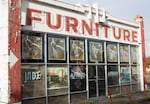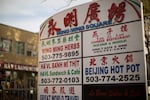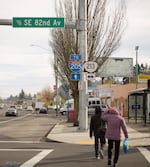
As part of the effort to remake the neighborhoods along 82nd Avenue, community groups plan to turn this old furniture store into a community center and affordable housing.
Bryan M. Vance / OPB
Rosaline Hui moved to the United States from China 25 years ago, so she knows that new arrivals have a lot to learn.
The challenges include mastering basic skills, such as how to get an identification card or find a bank. But Hui recently taught a class on another important skill for newcomers in outer East Portland: simply crossing the street safely.
“A lot of these immigrants, they came from the village, and they told me they'd never seen traffic lights before,” Hui said. “They knew when they came here they had to learn what does red light mean, what does green light mean, but they don’t think about how important it is to follow the signs.”
Portland is known as a hub of smart urban planning. But parts of the city remain sprawling, messy and distinctly unfriendly to pedestrians and bike riders. They tend to be neighborhoods and communities that are poorer and more diverse.
The neighborhood where Hui works is a perfect example: 82nd Avenue used to represent the very edge of the city, the demarcation line where Portland’s logical street grid and tree-lined neighborhoods stopped and sprawling, car-centric Multnomah County began.

Trashcans along SE 82nd Avenue are adorned with the Jade District logo, the name for the collection of highly diverse neighborhoods that make up the area.
Bryan M. Vance / OPB
Today, city leaders call the area around 82nd and Division Street the Jade District. Crime reports and newspaper headlines have given this part of the city a reputation for grime and traffic. But its new name is a nod to what it also represents: One of the fastest-growing and most diverse Census tracts in all of Oregon.
"People say, 'Oh, 82nd is all prostitutes and secondhand car lots.' But for the Chinese community, we don't see this place like that," said Hui, who owns the Portland Chinese Times newspaper and is part of a coalition of business owners, neighbors and community organizers working to remake this neighborhood. "Some of those things are true, yes. But this is also our home."
Immigrants have given this stretch of town a true international flavor with restaurant, church and shop signs in Chinese, Vietnamese and Russian.

In the diverse East Portland neighborhoods that make up the Jade District, businesses routinely list information in multiple languages.
Bryan M. Vance / OPB
"In a funny way, this is exactly the kind of neighborhood we’re supposed to be encouraging – a place where everything you want exists within easy reach. If you’re an immigrant, you can find your market, restaurants that have the food you know, people who speak your language,” said Thuy Tu, a civil engineer and consultant who has been working on Jade District improvements. “Everything is here for those communities that have already been displaced from their own country.”
Compared to the rest of Portland, this part of the city remains affordable — perfect for people pushed out of more affluent areas near the urban core and all those new immigrants with nowhere else to go.
But from a planning perspective, much of East Portland is a nightmare. Main streets are extra wide. Side streets lack sidewalks, or even pavement. Single-family farm homes sit next door to used car lots and in the shadow of big new apartment buildings.
“It’s not the Portland we all expect Portland to be,” said Radcliffe Dacanay, a city planner. “There were just different rules and regulations for when a lot of the development was opening, just the underlying bones,” he said of the region annex by the city in the 1980s.
Poor underlying bones and rapid growth conspire to make this one of the most dangerous places in the state to be a pedestrian. That’s an especially big problem for those new immigrants.

Pedestrians cross the busy intersection of SE 82nd Avenue and SE Division Street on Sunday, Nov. 19, 2017.
Bryan M. Vance / OPB
"Everybody wants to talk about hashtag resist, hashtag whatever, but sometimes the most radical thing is to ask for a sidewalk. Sometimes the most radical thing to ask for is a stop sign, ask for a crosswalk, ask for a sidewalk, ask for pothole repair, ask for gardens," said Zahir Janmohamed, who until recently was a community organizer with the nonprofit Asian Pacific American Network of Oregon, or APANO.
“Sometimes really small improvements can make a big difference," Janmohamed added. "If we could get more crosswalks or street signs in Chinese and other languages besides English, that would save lives.”
But big changes are also coming, including Portland Community College's new southeast campus and a community center and affordable housing project being developed by APANO, Rose Community Development and the Metro regional government. Metro and TriMet also plan to spend millions making bus service faster and more frequent here.
All those improvements raise another question: What happens if this part of East Portland gets too nice?
“When we talk about gentrification, we think about whites coming in and pushing out other races,” Janmohamed said. “But we also have the case of wealthy Asian investors and others who are just selling to the other top person, we could have lower income Asian families being displaced by higher-income Asian families. That's also a form of displacement that we need to be concerned about.”
The idea of gentrification along 82nd Avenue may seem outlandish right now. But Portland has learned the hard way that well-intentioned urban renewal can bring surprising and unintended consequences.
Related: Cyclist Killed By Motorist In Southeast Portland
Rosaline Hu points out that many of the businesses that give the Jade District its name were priced out of downtown Portland within the past two decades, in part because of government-driven improvements that ended up raising property values and rents.
“When I first came to Portland, I went to Chinatown every weekend to have dim sum and buy groceries down there,” Hui said. “Now everything is gone in Chinatown. I don’t want to see what happened to Chinatown happen here.”
This used to be the edge of the city. Now it’s smack in the middle of Portland’s ongoing quest to figure out its future.